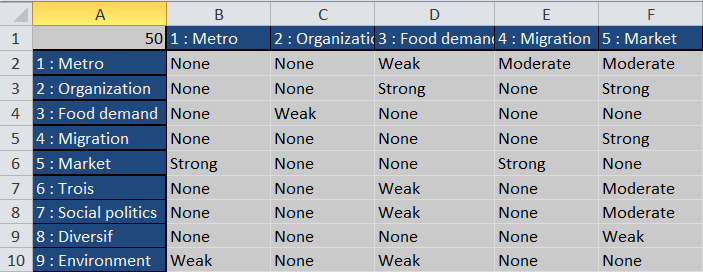
Frequently Asked Questions
- How should I format my Excel input file to be processed with FLMICMAC?
- What is the usual workflow of FLMICMAC?
- What do you mean by 'dubious' and 'potential' entries in the input matrix?
- How does FLMICMAC deal with 'dubious' and 'potential' entries?
- Any other thing that can be useful to know ...
- How should I format my Excel input file to be processed with FLMICMAC?
- What is the usual workflow of FLMICMAC?
- What do you mean by 'dubious' and 'potential' entries in the input matrix?
- How does FLMICMAC deal with 'dubious' and 'potential' entries?
All the data should be located in the first sheet of the Excel book. The rest of the sheets will be ignored. The top left corner must contain the number of variables of the problem, as a positive integer. The first row and first column must contain the names of the variables. The rest of the cells must contain a linguistic label (case sensitive). The image below shows a fragment of a sample Excel input file. The background color of the cells is irrelevant.

First, the user must select a Excel file (*.xls), that will be uploaded to our server, and the
first sheet will be parsed.
Second, the system will show a list of the labels found in the sheet after a case-sensitive search.
Third, the user must sort the labels by dragging up and down, so that a total order is defined
over them. Please make sure that the label used for No influence is located on the top of the list after sorting.
Fourth, next to each label, the user can define a Triangular Fuzzy Number (TFN) to represent the label. It must be
composed of three positive real values (a,b,c) so that a ≤ b ≤ c. Note these values should be coherent
with the ordering defined over the labels in the previous step.
Dubious entries are those cells about which the user is not sure. They represent cases where the strength of the relation between two variables is not clear, even though the user is forced to choose one value to assess that relation. For example, we might have chosen the label Weak to assess the influence of variable i over variable j, but we know that it could also be either non-existent (None) or Moderate. Instead of letting the user specify a customized, very wide fuzzy number to state her uncertainty about the strength, we prefer to let her indicate it by using parentheses around the label, as in (Weak).
Potential entries represent relations which are currently non-existent but could appear in the future. This concept is introduced by Godet in his MICMAC proposal. The user should explicitly state which label she has employed in his data to represent a Potential relation.
In the initial phase that takes place just after hitting the "Launch FLMICMAC" button, dubious relations are treated as if they were certain (i.e., the linguistic label inside the parentheses is used), and potential relations are replaced by the no-relation label, as if the user had written None in that entry. This would be the expected behaviour if we take into account Godet's definition of a potential relation, as one which does not currently exist but could manifest in the future.
In the optional sensitivity analysis phase, a
